Meilleures Idées de Prompts d'Art AI pour Stimuler la Créativité
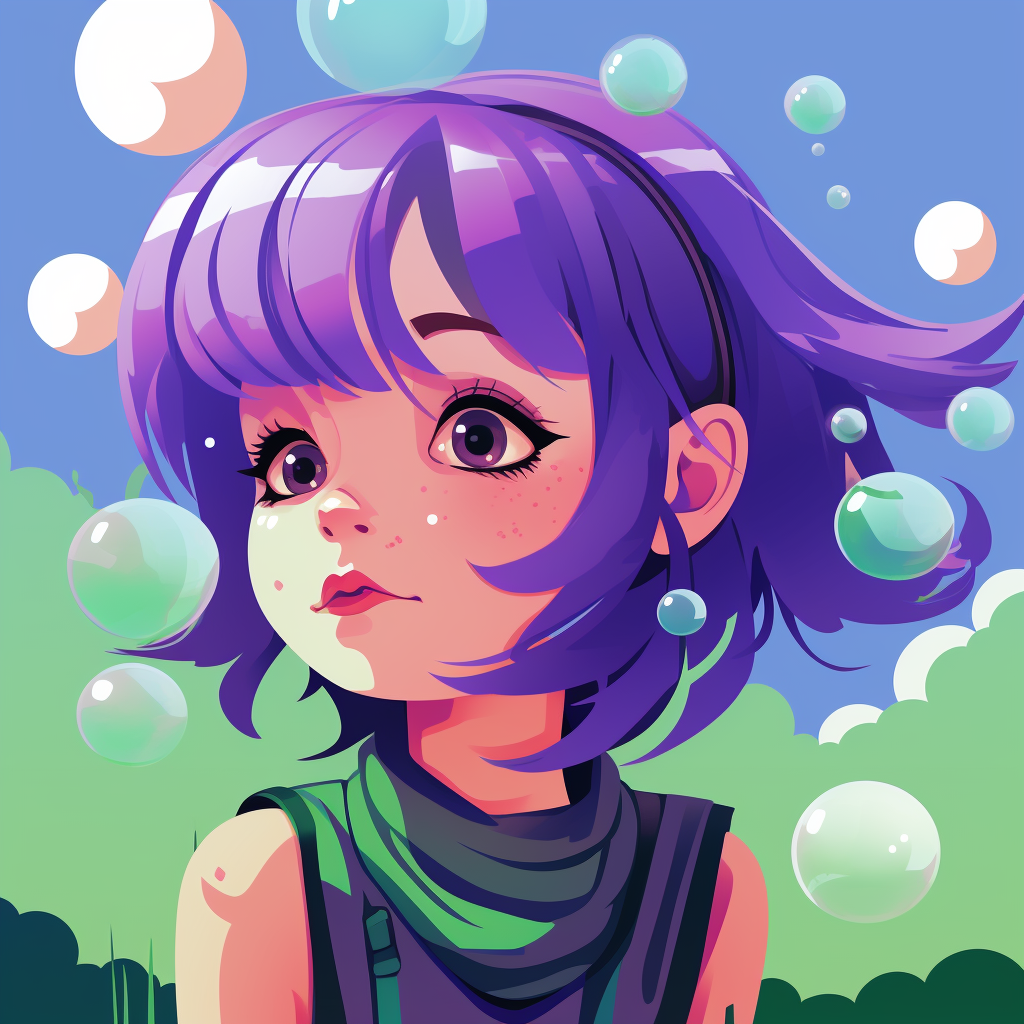
Le principe fondamental de la création artistique avec l'intelligence artificielle est simple : plus l'entrée est précise, plus la sortie est impressionnante ! Dans le monde de l'intelligence artificielle, le terme "entrée" fait référence aux prompts, tandis que "sortie" désigne l'œuvre d'art générée en conséquence. Actuellement, tant les artistes professionnels que les designers amateurs tirent parti des prompts d'art AI pour créer des chefs-d'œuvre visuellement saisissants. Cette nouvelle forme d'expression artistique redéfinit continuellement nos approches créatives, attirant de plus en plus de personnes à rejoindre cette révolution artistique.
Avez-vous déjà eu l'impression que créer des prompts d'art AI est comme lancer un sort ? Lorsque toutes les tentatives semblent échouer, comment ces maîtres créatifs utilisent-ils des outils comme Midjourney et DALL-E pour produire des effets visuels époustouflants ? La vérité est qu'avec les bonnes techniques, vous pouvez facilement créer des œuvres d'art AI de haute qualité.
Que sont les Prompts d'Art AI ?
Les prompts d'art AI sont des directives entrées dans des générateurs d'art alimentés par l'intelligence artificielle pour stimuler leur créativité et générer diverses œuvres d'art et images. Imaginez donner des instructions à un artiste, alors que cet artiste est en fait un programme informatique sophistiqué. Les prompts d'art AI efficaces doivent être clairs, spécifiques, détaillés et créatifs.
Pourquoi des Prompts AI Excellents sont-ils Cruciaux ?
Pour créer des images de qualité, les générateurs de contenu AI dépendent entièrement de leur compréhension de ces prompts. Ils comparent le contenu du prompt avec les données de leur bibliothèque d'apprentissage. Ainsi, la qualité des prompts est primordiale dans ce processus. Il n'y a pas de formule fixe pour rédiger des prompts efficaces ; il peut être nécessaire de réaliser plusieurs expériences pour que le modèle génère une image qui correspond parfaitement à vos attentes. Le processus itératif non seulement offre plus d'inspiration, mais vous aide également à comprendre comment les différents éléments des prompts impactent l'art généré.
Comment Fonctionnent les Générateurs d'Art AI ?
Avant de plonger dans les techniques de prompts d'art AI, il est essentiel de comprendre comment ces générateurs fonctionnent. N'oubliez pas que les applications d'IA générative sont essentiellement des machines, fondamentalement différentes de la cognition humaine. Ces programmes ne comprennent pas l'essence du monde ; ils fonctionnent sur la base des caractéristiques et des modèles présents dans les données d'entraînement. Par conséquent, des prompts vagues comme "beau visage" peuvent souvent donner des résultats médiocres, tandis que des descriptions plus spécifiques, comme "personnage symétrique avec des lèvres pulpeuses et des yeux verts", tendent à être plus efficaces. Pour obtenir des résultats idéaux d'un générateur d'art AI, vous devez fournir des descriptions claires et détaillées. Les prompts d'art AI efficaces doivent inclure des descriptions spécifiques, des formes, des couleurs, des textures, des motifs et des styles artistiques, permettant au générateur d'utiliser des réseaux neuronaux pour créer le meilleur effet visuel.
Avantages de l'Utilisation des Prompts d'Art AI
Utiliser des prompts d'art AI présente plusieurs avantages significatifs, notamment dans le soutien au processus créatif :
- Efficacité Temporelle : De bons prompts peuvent produire des images en quelques secondes, éliminant des heures de travail artistique manuel. Même si vous devez ajuster les prompts pour obtenir un résultat sur mesure, cela ne prend généralement que quelques minutes.
- Efficacité Économique : Le temps, c'est de l'argent ; en exploitant des outils AI à faible code ou sans code, les entreprises peuvent augmenter considérablement l'efficacité de la production de contenu tout en réduisant les coûts.
- Cohérence et Accessibilité : Les générateurs d'images AI utilisent des commandes textuelles et l'apprentissage automatique pour obtenir de la cohérence, aidant à maintenir un style de conception unifié permettant à quiconque — peu importe son niveau d'expertise artistique ou d'IA — de créer facilement des images visuellement attrayantes.
- Polyvalence et Innovation : Avec la flexibilité de la création d'art AI, les artistes peuvent explorer divers styles et techniques. Ces outils encouragent à dépasser les limites conventionnelles, menant à des résultats artistiques inattendus.
Défis et Obstacles de l'Utilisation des Prompts AI
L'essor de l'IA dans la création de contenu a suscité des discussions et des débats intenses parmi les artistes. En plus des préoccupations concernant les droits d'auteur, la propriété et le scraping de données, il existe une anxiété persistante concernant la dévaluation de l'art humain. Un problème courant lié à l'utilisation des prompts AI est leur nature restrictive ; puisque les générateurs fonctionnent uniquement selon ces prompts, il y a une liberté limitée d'expérimenter avec les styles et les éléments. L'art généré manque souvent d'unicité et tend à être formuleique, tandis qu'une dépendance excessive aux prompts AI peut étouffer la voix créative de l'artiste.
Malgré ces défis, les générateurs d'images deviennent progressivement d'excellents outils pour la création de contenu. Au final, il ne reste qu'à surmonter un obstacle : comment créer des prompts efficaces, pertinents et accrocheurs.
Comment Écrire d'Excellents Prompts d'Art AI ?
Maintenant que vous comprenez les principes fondamentaux des générateurs d'art AI, il est temps de commencer à créer vos prompts. Voici des conseils pratiques pour rédiger d'excellents prompts d'art AI :
1. Décrivez le Contenu de l'Image
Lorsque vous rédigez des prompts, assurez-vous de décrire en détail le contenu de l'image désirée. Est-ce une peinture, un croquis ou un rendu 3D ? Doit-elle ressembler à une photo ou avoir un aspect plus illustratif ? Par exemple : générez une… photo/rendu 3D/croquis.
2. Spécifiez le Thème
Tout prompt d'art AI devrait inclure une description du thème de l'œuvre. Cela peut être n'importe quoi, d'une personne, un animal ou un objet à des concepts abstraits. Voici un exemple de prompts d'art AI de Midjourney : « Une illustration d'un hibou. »
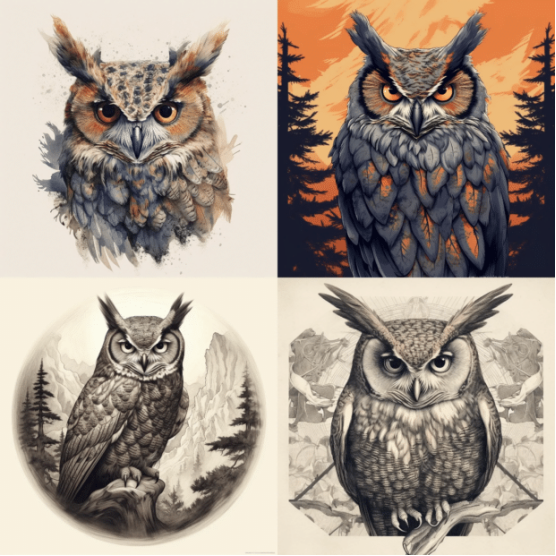
3. Ajoutez des Détails Pertinents
Améliorez votre prompt en ajoutant des détails liés aux éléments de l'image. Cela peut inclure des couleurs, des formes, des tailles et des textures. Voici un autre exemple provenant de Midjourney : « Une illustration d'un hibou rouge avec des yeux brillants et bleus. »
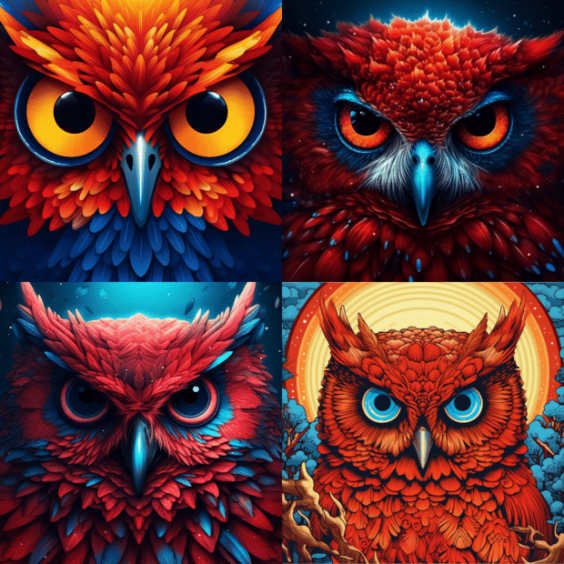
4. Décrivez la Forme et le Style
Fournissez des informations détaillées concernant le style artistique et la forme, surtout si vous recherchez un effet visuel spécifique. Vous pouvez inclure des mots-clés descriptifs tels que "abstrait", "minimaliste" ou "surréaliste". Un exemple de Midjourney : « Une illustration d'un hibou rouge avec des yeux brillants et bleus dans un style d'expressionnisme abstrait. »
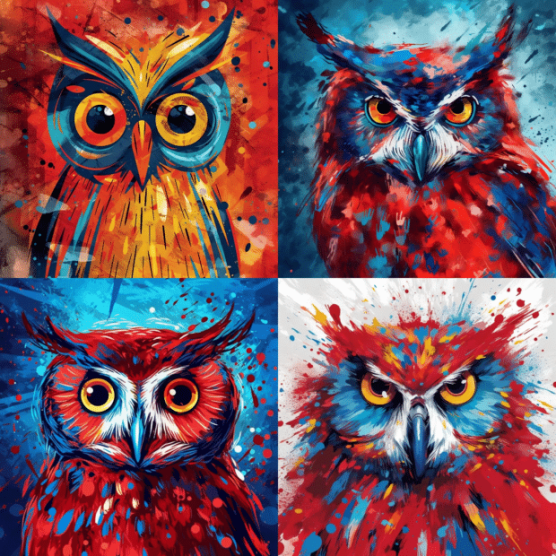
5. Définissez la Composition
Utilisez des mots-clés pour définir la composition de l'image, y compris la résolution, le style d'éclairage, le rapport d'aspect et l'angle de la caméra. De cette façon, vous pouvez transmettre plus précisément votre vision créative. Un exemple de Midjourney : « Une illustration d'un hibou rouge dans un style d'expressionnisme abstrait avec un éclairage volumétrique, présentant des yeux brillants et bleus. »
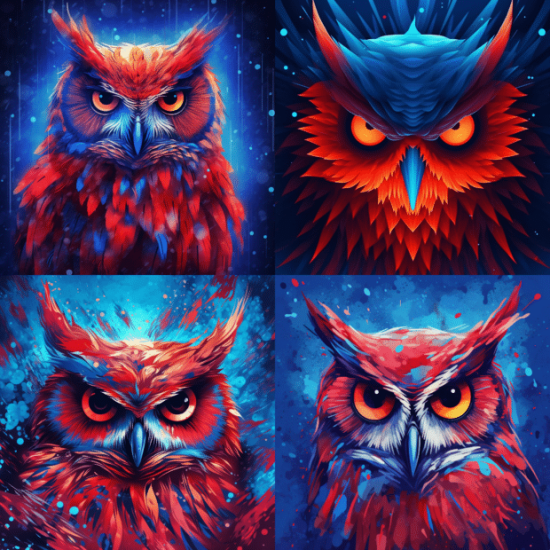
En examinant ces exemples, vous pouvez voir comment chaque image évolue avec le changement de prompts.
Points Clés pour des Prompts d'Art AI Réussis
Assurez-vous d'inclure les détails suivants pour créer des prompts efficaces : format de l'image, thème, détails pertinents, caractéristiques de style et informations sur la composition. Tout d'abord, décidez du type d'art : s'agit-il de photographie, de croquis, de peinture à l'huile ou de rendu 3D ? Ensuite, clarifiez le sujet principal, en englobant des détails spécifiques comme la couleur, la forme, la taille et la texture pour guider l'AI à générer des effets artistiques précis.
Lorsque vous décrivez le style, utilisez des mots-clés tels que "abstrait", "minimaliste", "expressionniste" ou "surréaliste" pour transmettre les caractéristiques artistiques que vous souhaitez mettre en avant. Enfin, définissez la composition aussi précisément que possible, en indiquant le genre artistique, le style d'éclairage, les proportions et les angles. Plus vos prompts sont clairs, plus les images générées seront détaillées et nuancées.
Conclusion
Utilisez les outils XXAI pour réfléchir et créer des prompts qui peuvent générer des images époustouflantes. Imaginez que l'inspiration est à portée de main ; les prompts artistiques de XXAI et les outils générateurs d'art AI vous soutiendront pleinement pour développer des idées visuelles passionnantes. Saisissez dès maintenant vos réflexions et préférences, et le modèle AI vous recommandera des thèmes et concepts qui correspondent à ces exigences, vous aidant ainsi à créer facilement des prompts d'art parfaits et à vous lancer dans votre aventure artistique avec l'IA !